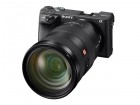
Sony’s a6500 arrived just eight months after the a6300, which is a fairly short time for an update. So what exactly changed between the two? Here’s a rundown of the main differences. Design and ergonomics The two models have a very similar form, with the a6500 just being a touch heavier and thicker (which appears to be at least partly down to a new image-stabilisation system, covered below).
The a6500's grip has been restyled, while the shutter release button appears to be slightly larger too. The a6500's command and mode dials now also share the same finish around the sides, which wasn't previously the case.
Sony a6300
Sony a6500
Another change that's not as easy to appreciate is that the eyecup on the a6500 has been redesigned to be slightly softer than the one on the a6300.
There's also been a small shift in the physical controls on the newer a6500. The customisable C1 and C2 buttons, which on the a6300 were found on the top and rear plates respectively, are now both found on the a6500's top plate.
Additionally, and a third C3 button is twinned with the delete button, exactly in the same place as the a6300's C2 button.
Sony a6300
Sony a6500
Other than that, it’s pretty easy to mistake one for the other, although when you power up the camera you will be greeted with a refreshed interface, one that makes use of names for each section and colours to help you find things more easily. Sony's menu system has long been criticised for being awkward to navigate, so this is welcome move.
Image quality
The heart of each camera is very similar. Each model is designed around a 24. 2MP Exmor APS-C sensor that's designed with copper wiring for fast readout speeds. The two cameras also share a BIONZ X processing engine, although the a6500's engine has a new front-end large scale integration (LSI) chip that's said to benefit both stills and video quality.
In particular, its processing power has allowed for the buffer to now store up to 307 JPEGs when shooting continuously, which will no doubt please those who intend to use the a6500 for action photography.
Sony a6300
Sony a6500
The other big shout on the a6500 concerns image stabilisation. Whereas the a6300 can only take advantage of image stabilisation when used with a lens that incorporates the technology, the a6500 has image stabilisation built right into the body itself.
Sony states that this employs a new gyro sensor and works over five axes – yaw, pitch, roll and shifting across the vertical and horizontal – and this has a fairly significant compensatory effect of five stops.
The obvious advantage of this is that the camera can apply this benefit to non-stabilised lenses, although the two systems can also work in tandem with one another, should you mount a stabilised lens.
Special Features
The sensor inside each camera is designed with 425 phase-detect AF points, and this works with in concert with a contrast-detect AF system to provide Sony's 4D FOCUS technology. This is assisted by High-density Tracking AF technology to help keep a lock on subjects as they move around the scene.
While the a6500 offers the same Multi, Centre and Spot metering modes as the a6300, it also throws in two new ones. These are Highlight and Entire Screen Average options, which brings the total to five.
Another key difference between the two models is that the a6500’s tilting rear display is responsive to touch, whereas the a6300’s is not. This can be used to determine the focusing point for stills although you can also use it during movie recording to pull focus between subjects.
Sony a6300
Sony a6500
Although Sony hasn't stated how long it reckons the a6300's mechanical shutter would last, the shutter on the a6500 is said to be improved. Here, it is claimed to last for 200,000k cycles, which is a perfectly respectable figure for such a model.
Battery life on the A6500 has taken a hit, however. Whereas Sony quotes a figure of 400 frames with the rear LCD and 350 frames with the viewfinder on the a6300, the a6500 only manages 350 frames with its LCD and 310 with its EVF.
Video quality
As their top plates make clear, both cameras are capable of recording 4K footage, and this is captured in the 4K UHD format (3840 x 2160 pixels). Perhaps the main advantage with video quality on the a6500 is one that’s already been mentioned, namely built-in image stabilisation, although another new feature is the Slow & Quick (S&Q) mode.
This option, which also features inside the recent A99 II, allows you to vary the frame rate when recording video between 1fps to 120fps (inclusive).
Sony a6300
Sony a6500
Conclusion
As you'd expect, all of the a6500 extra functionality comes at a premium. At the time of writing the a6500 is roughly 1. 5x pricier than the a6300 (based on a body-only option), a figure that doesn't seem unreasonable when you consider its advantages.
Sony a6300
Sony a6500
So who might be tempted by the a6500? With its increased buffer and built-in image stabilisation, the obvious answer is anyone who shoots fast action or who uses telephoto lenses with any regularity, although the latter feature should also appeal to anyone using it for more general day-to-day shooting with a few unstabilised optics.
Nevertheless, given that both cameras use the same sensor, focusing system and viewfinder, many users would no doubt be happy with what the a6300 has to offer. That camera still is, after all, a formidable mid-range option.
. digitalrev.com2017-3-17 03:00






